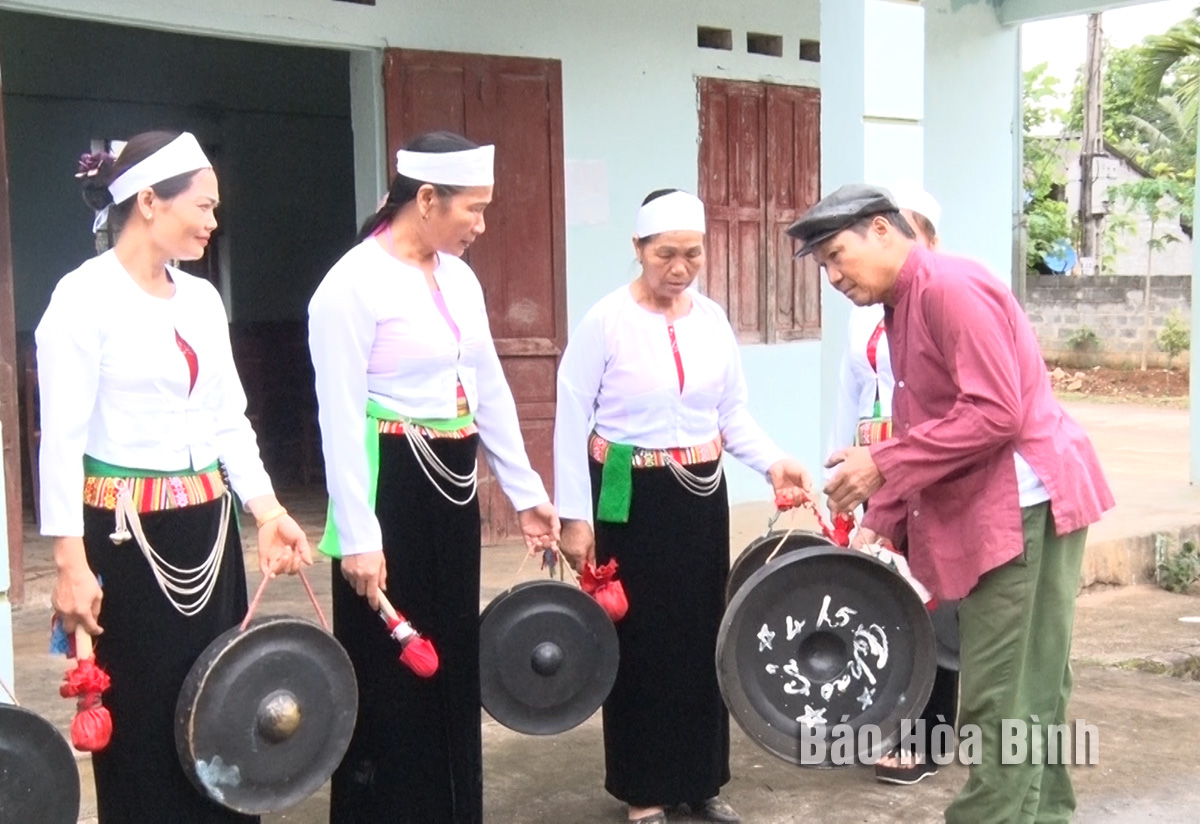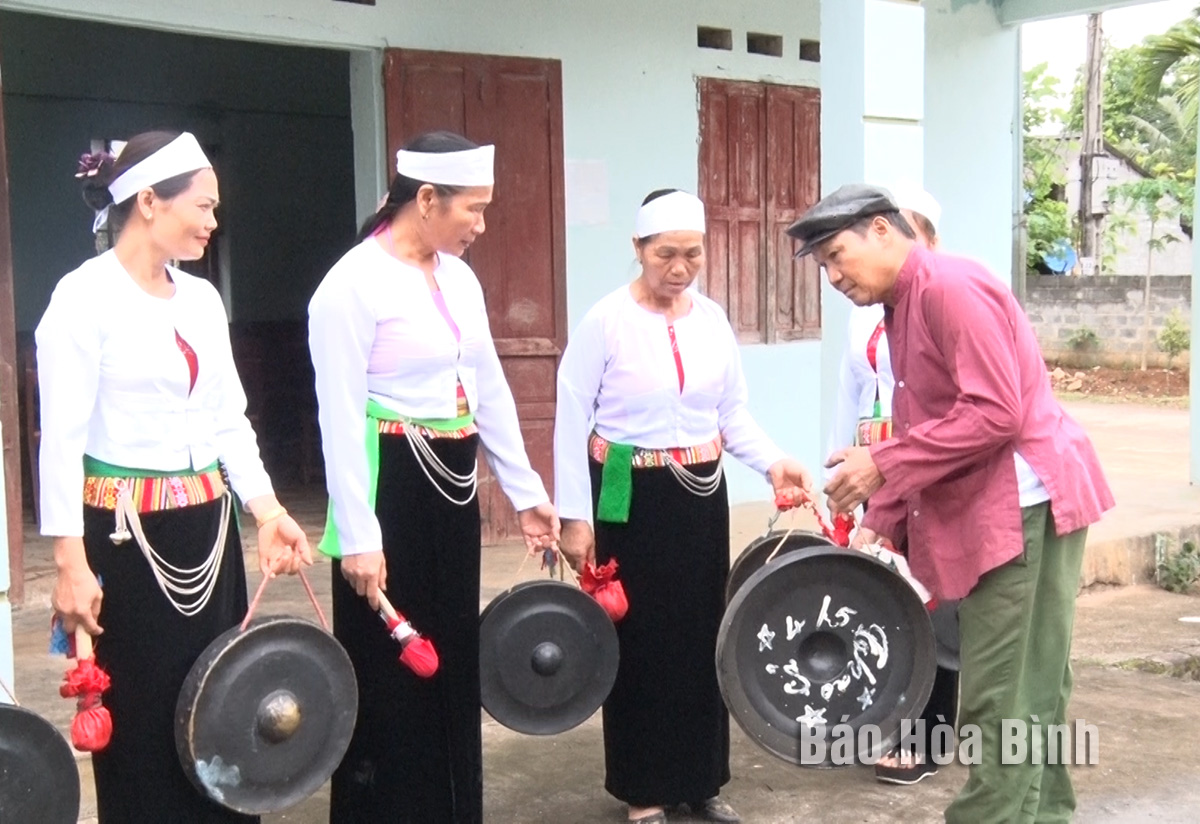
Kim Boi district has worked to preserve and promote the cultural trait of the local Muong ethnic minority group, taking them as a mission to popularise and effectively carry out the Party’s guidelines and the State’s regulations.
Artisan Bui Tien Xo is
instructing members of the Muong gong club in Thao Ca hamlet, Vinh Tien commune
how to play chieng (gong).
The district has directed competent sectors and
branches to enhance communications work to raise public awareness of policies
on preserving and promoting cultural heritage. Besides, it has paid due
attention to safeguarding traditional folk games, honouring artisans, families
and community with standout contributions to the preservation work, and promote
the restoration of traditional festivals such as Muong Dong festival, Lap
communal house festival, and Sim pagoda festival.
The culture and information bureau proposes the
district organise art performance programmes and create traditional cultural
space to preserve and develop the culture.
According to head of the bureau Nguyen Thanh Ha,
a number of practical measures have been rolled out to keep the Muong ethnic
culture alive such as arranging training classes for cultural officials and Mo
Muong artisans, debuting the club to preserve and promote Mo Muong cultural
heritage, and organising contest and festivals.
Besides, the district has listed local
intangible cultural heritage, handed the items on younger generations and
honour artisans, she said, adding the State has bestowed the artisan title on
nine folk artists, including seven Mo Muong, one Muong folk singing and one
Muong gong artist.
Meritorious artisan Bach Thi Dao in Beo hamlet,
Xuan Thuy commune, has had a strong passion for Muong folk songs since she was
a little girl. She established a Muong folk singing and gong club in 2017 with
a view to teaching local kids about the Muong tradition.
Statistics showed that there are 45 shamans in
Kim Boi district who have a great deal of knowledge and a deep insight into the
Mo Muong values. They have conducted Mo Muong rituals in line with current
regulations to preserve and promote its values.
In the coming time, Kim Boi district will
continue communications work to raise public awareness of the preservation of
the traditional values, and encourage communes and town to establish cultural
clubs and honour those who make contributions to safeguarding the local
cultural treasure.
With an increasingly vibrant and widespread emulation movement aimed at building cultured residential areas and cultured families, Yen Thuy District has been making steady progress toward improving both the material and spiritual well-being of its people, while fostering a civilized, prosperous, beautiful, and progressive community.
Once lacking recreational spaces and community facilities, Residential Group 2 in Quynh Lam Ward (Hoa Binh City) has recently received attention for the construction of a new, spacious, and fully equipped cultural house. The project followed the model of state support combined with public contributions in both labor and funding.
The "All people unite to build cultural life" movement, which has been effectively integrated with Kim Boi district’s socio-economic development goals, is fostering a lively spirit of emulation across local residential areas, hamlets, villages, public agencies, and enterprises. In addition, through the initiative, traditional cultural values are being preserved and promoted, while community solidarity and mutual support in poverty reduction and economic development are being strengthened.
A working delegation of the Hoa Binh provincial People’s Committee led by its Permanent Vice Chairman Nguyen Van Toan on June 11 inspected the progress of a project to build the Mo Muong Cultural Heritage Conservation Space linked to tourism services in Hop Phong commune, Cao Phong district.
Born and growing in the heroic land of Muong Dong, Dinh Thi Kieu Dung, a resident in Bo town of Kim Boi district, in her childhood was nurtured by the sweet lullabies of her grandmother and mother. These melodies deeply imprinted on her soul, becoming an inseparable part of her love for her ethnic group's culture. For over 20 years, this love for her hometown has driven Dung to research, collect, and pass down the cultural values of the Muong people to future generations.
In the final days of May, the Ethnic Art Troupe of Hoa Binh Province organized performances to serve the people in remote, mountainous, and particularly disadvantaged areas within the province. These were not just ordinary artistic shows, but they were the meaningful journeys aimed at spreading cultural values, enhancing the spiritual life of the people and contributing to the preservation of ethnic minority cultural identities.



